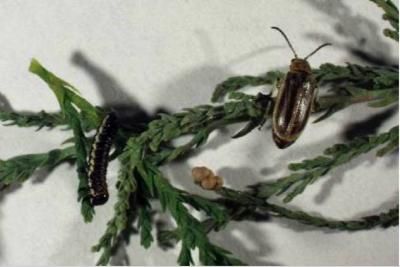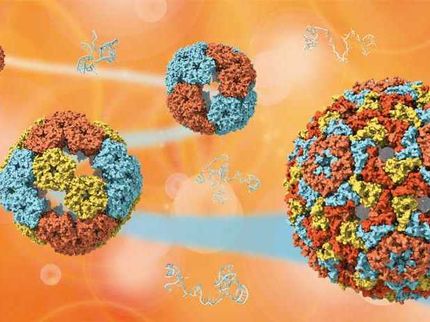Tamarisk biocontrol efforts get evolutionary boost
UC Santa Barbara scientists trying to control the invasive tamarisk plant have been getting a boost from evolution, in the form of a rapidly evolving beetle that has been changing its life cycle to more efficiently consume the noxious weed. Their findings, in a paper titled "Evolution of critical day length for diapause induction enables range expansion of Diorhabda carinulata, a biological control agent against tamarisk," are published in the journal Evolutionary Applications.

This is a tamarisk leaf beetle.
University of California Santa Barbara
"This is one of the clearest cases of rapid evolution," said co-author Tom Dudley, who is the principal investigator at UC Santa Barbara's Marine Science Institute Riparian Invasive Research Laboratory. The tamarisk leaf beetle, he explained, has managed to delay its entry into hibernation to adapt to the shorter days of the southern region of the United States. That adaptation in turn allows the beetle to survive until spring, while prolonging the time it has to reproduce, and increasing its effectiveness at controlling the invasive weed.
Also known as saltcedar, tamarisk is a shrub that was introduced to the United States from Eurasia in the 19th century. Since then, what was intended to be an ornamental plant has become a highly invasive weed, establishing itself in riparian areas and consuming valuable water supplies, as well as competing with native vegetation.
"It makes a lousy habitat for wildlife," said Dudley, adding that the plant is also a fire hazard, as it is highly flammable even when green and healthy.
However, the weed is an ideal home for the tamarisk leaf beetle, another Eurasian species that eats only the foliage of tamarisk and hibernates in its leaf litter. After almost a decade of testing, the insect was released into tamarisk-infested areas in 2001 by USDA and collaborating researchers, including Dudley and first author Dan Bean, who, at the time, was an associate researcher at UC Davis. The two, along with co-author Peter Dalin, a UCSB post-doctoral scholar who is now with the University of Agricultural Sciences in Uppsala, Sweden, have been following the beetle's progress across many parts of the continent.
The beetle successfully established in the northern regions of the United States, where the day lengths matched those of the beetle's native Kazakhstan and western China.
However, according to Dudley, the shorter day lengths of the southern regions during its mid-spring to late summer reproductive season not only decreased the window of time for reproduction, but they also presented something of a false cue to the beetles, which took the shorter day lengths as a sign to enter diapause (hibernation), before the onset of winter. Instead of feeding and reproducing, the beetles would go into early diapause, using up their metabolic reserves before the arrival of spring, resulting in their death.
However, as the researchers continued to monitor and test the beetles, they found that about seven years after their introduction, those in the southern regions of the U.S. had delayed their diapause by two weeks, adjusting their hibernation time so that the next generation was better suited to the season. Between 2003 and 2008, for instance, tamarisk leaf beetles at eastern Colorado's Arkansas River went from going dormant in late July to remaining active until mid-August.
"This has resulted in the first successes for the biocontrol program for tamarisk in Colorado's Arkansas River Basin," said Bean, who is now with the Colorado Department of Agriculture.
The same genetic mechanism also made it possible for the insect's continued southern dispersal, and further biocontrol of the invasive tamarisk.
"It's a very cost-effective way of containing the weed," said Dudley. In some places, the natural vegetation will be able to reestablish itself, while in places where the shrub was particularly pervasive, there will be restoration efforts, he added.
However, full eradication of the tamarisk is unlikely and is not the intent of classical biocontrol, said Dudley. After almost two centuries of establishing itself in the United States, the plant has become part of the ecosystem. In some areas tamarisk even provides habitat to the willow flycatcher, a federally listed bird that nests in the shrub where the preferred native plants have been displaced, although only in places where some native vegetation still exists.
























































